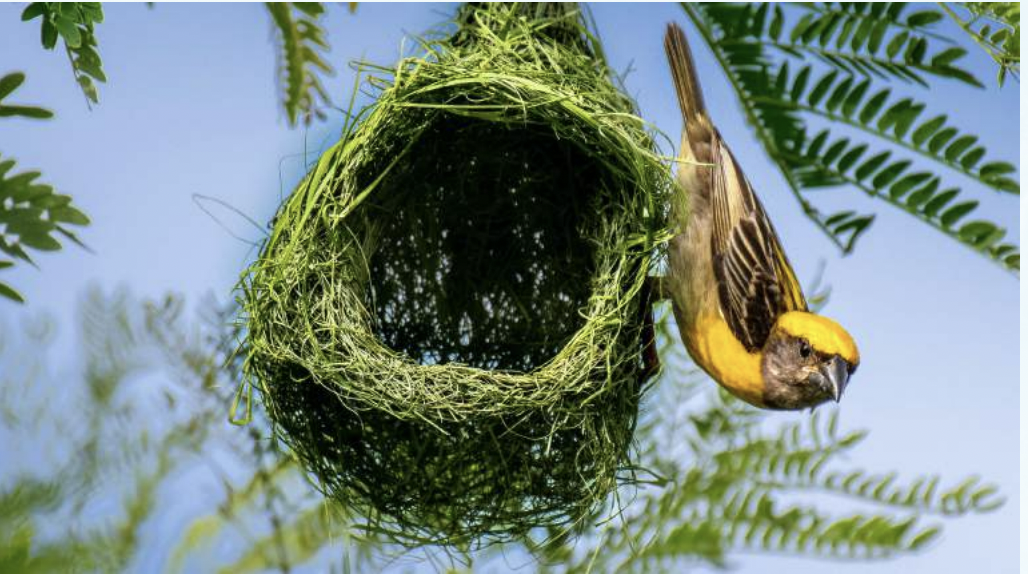One rainy day, after the storm calmed down and the sky was clear, I went on the terrace to enjoy the weather. An exquisite nest hanging on the branch of a tree in our neighborhood caught my eye. On another branch of the tree were its owners perching and chirping as if they were making their presence known, guarding their valuable home from predators. The nest was tear-shaped with an entrance at the bottom carefully weaved with twigs and grass strands. To my surprise the nest was so beautifully crafted that no strong wind, heavy rain, or extreme heat of the sun could damage it. My curiosity to know more about the nest and its weavers led me to a Google search. I learned that the nest in question belonged to the Baya Weaver (Ploceus philippinus) which is most commonly found in India.

Weavers or weaverbirds are small birds from the Ploceidae family and derive their name from the nests they weave. People around me have witnessed Baya Weavers pinching out fine grass strands from the bottom of gahnia grandis and flying them to their nests. They tuck the strands around, tie, and weave them to give the nests their signature bulbous look. Their nests are often found hanging near water bodies at a height on trees and sometimes on high rise electric wires. Sometimes, they use blobs of mud perhaps to add extra comfort inside them. Their nests often have more than one chamber and entrance.
Fascinated with these intelligent creatures I pondered on how the houses we live in are designed by architects and built by construction workers. Only trained human beings can design or build a house. They are assisted by machinery such as concrete mixers and rely on the availability of construction materials. From simple caves, thatched roofs, and mud walls, to the tallest buildings which are resistant to earthquakes, human beings have learned over the ages to customize the construction of houses and apartments according to the needs of different climates and population growth. There are proper degree courses -offered by universities around the globe- to master the civil engineering techniques required to construct buildings .
The fact that the human being is the most intelligent creature on earth justifies the development of the construction industry but how do tiny weaverbirds learn to build their hanging nests? Who could possibly have taught them to smartly construct their nests away from the reach of predators? How did they master the art of building a nest that is wind, rain, and heat-proof? As soon as the chicks grow, they leave the nest to have a life of their own. They don’t learn from their parents the art of nest building; so how do they build their own nests? Who is their teacher? Just as architects and engineers require a professional degree in the field to design tall buildings and the construction workers require a lot of work experience before they are able to erect a straight wall, is it not necessary that the weaverbirds must have a degree or work experience too? As a matter of fact, weaverbirds do not have any professional degree or work experience.
They have been bestowed with the necessary knowledge to design the nest but who is this bestower? How knowledgeable and prudent can the bestower be who has created the weaverbirds with such amazing skills to build beautiful nests? Does it not indicate that their creator must be extremely wise? There are several species of the weaverbirds found across the globe. Each species has a different set of unique features and birds from the same species have strikingly similar features. For instance, every baya weaver builds a similar nest. This fact indicates that the creator of all weaverbirds is One. The weaverbirds are being inspired by the same Source – their Creator, the One who is All- Knowledgeable and All-Wise because only one who has perfect knowledge and wisdom can create such wonderful living creatures. The suspended nests indicate that the creator of all weaverbirds must be the Best of Fashioners for He has inspired them to tailor such amazing nests. He must be the sole Sustainer since He provides sustenance to all the weaverbirds just as He does to all other living creatures without any delay. By guarding their nests from the predators, they manifest the reflection of the Ever-Watchful Guardian and Protector.
While skylines are the highlight of metropolitan cities, the hanging homes of the weaverbirds depict the beauty of nature. The sight of a suspended nest being built by a bird should make us appreciate their Maker who has inspired them to build such delicate yet strong homes. The observation of nest building by a small bird should compel us to reflect on the esoteric meaning behind their existence, a meaning which is pointing to something else other than its own; and that is the presence of the Almighty who has designed the universe so beautifully that every phenomenon is a manifestation of His signs. As we learn the esoteric meanings of these revealed signs in our everyday life, we become humbler and kinder by submitting ourselves to none but Him alone.